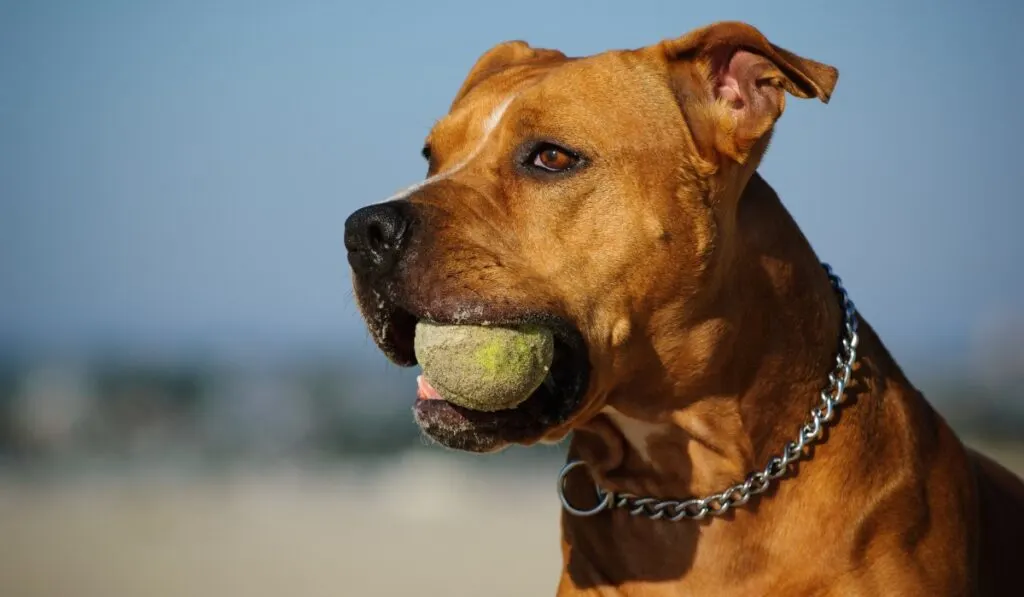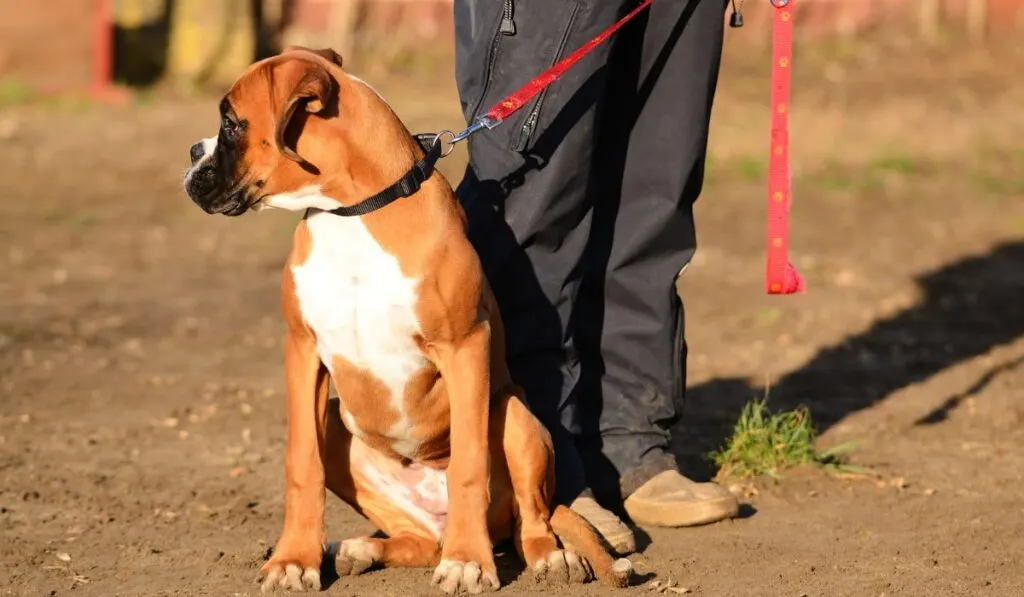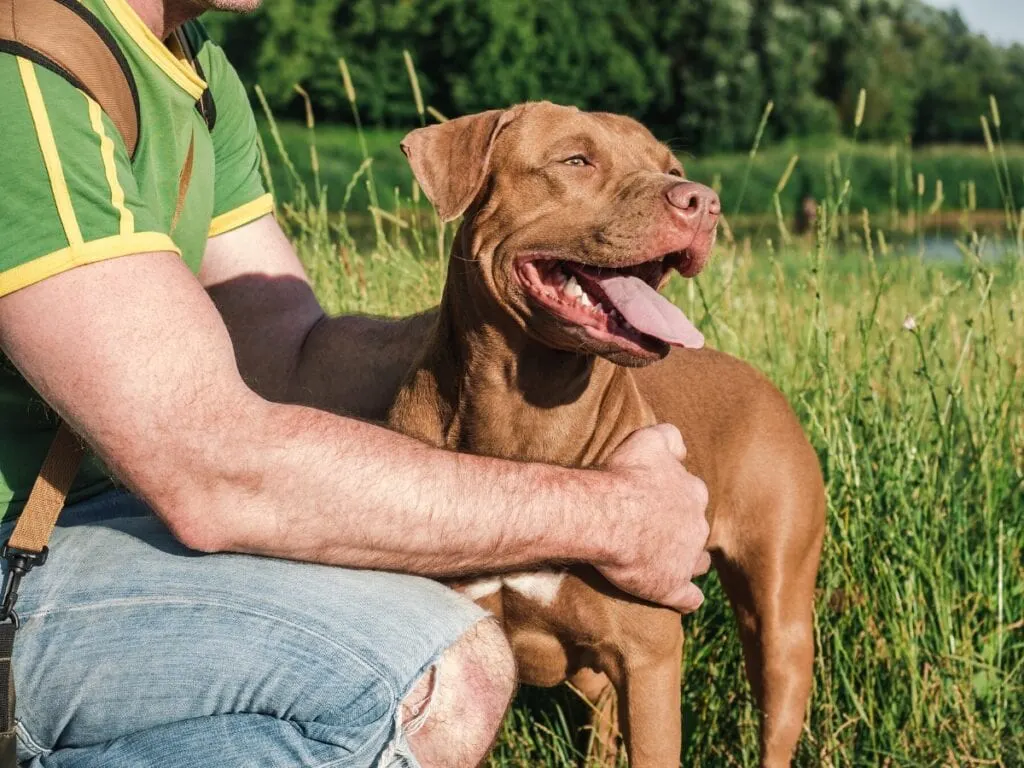Breed comparison is always relevant, whether you’re choosing a second dog or just curious about two similar breeds.
Two popular breeds often compared are the Boxer dog and the American Pit Bull Terrier. Both breeds are known for their loyalty, intelligence, and playfulness, but they have some key differences in their temperament, daily needs, exercise requirements, grooming, and health issues.
In this article, we will provide a detailed comparison of these two breeds and highlight where these breeds are similar but also different. This is the most detailed guide we’ve come across. So let’s get started!

Breed History: The Basics
Before comparing the Boxer dog and the American Pit Bull Terrier, let’s take a look at their breed history.
Boxer Dog History
The boxer dog was developed by crossing the now-extinct Bullenbeisser, a German hunting dog, with the English bulldog. This was done to create a breed of dog that had the strength and power of the bullenbeisser, but also the loyalty and tenacity of the bulldog.
Originally, the boxer was used as a working dog, particularly for hunting and guard dog duties. However, they quickly became popular as family pets due to their affectionate and loyal nature.

A fun fact about boxers is that they can stand on their hind legs and quite literally punch using their two front legs and paws. This is how many believe they got their name the “boxer” dog but this hasn’t been confirmed…
During World War I, the boxer was used by the German military as a messenger dog, and many boxers were trained for this purpose. After the war, boxers became popular in the United States, and the American Kennel Club recognized the breed in 1904.
Bullenbeisser – Wikipedia
American Pit Bull Terrier History
The American Pit Bull Terrier is a powerful and muscular breed that originated in England during the 19th century. Originally, pit bulls were developed from various terrier breeds and bulldogs for the purpose of bull-baiting, a bloodsport where a dog would attack a tethered bull.
When bull-baiting was outlawed in England in the 1800s, pit bulls were bred for dog fighting instead. However, this brutal activity was eventually outlawed as well, and the breed’s reputation suffered due to its association with violence.

Despite their troubled past, the American Pit Bull Terrier has become a popular breed in the United States, where they are known for their loyalty and affectionate nature. They are often used as family pets, as well as service and therapy dogs.
Unfortunately, pit bulls have also been involved in a number of high-profile attacks on humans and other animals. This has led to breed-specific legislation in some parts of the world, which aims to limit or ban ownership of pit bulls.
Boxer Vs. Pit Bull Temperament
Both Boxer dogs and American Pit Bull Terriers are known for their loyalty, intelligence, and affectionate nature. They absolutely love their families and want to be at the heart of all that’s happening. Still, there are a few differences that we’ll highlight below!
One thing to know right off the bat though, both breeds are highly loveable and when raised correctly, make excellent family pets.
Boxer Dog:
- Boxers are known for their playfulness and high energy level. They love to play with their owners and other dogs.
- They are also known for their love of people and make great family pets.
- Boxers are intelligent and respond well to training. However, they can be stubborn at times and require a patient and consistent approach to training.
- They are protective of their family and make great guard dogs. However, they can be too protective at times and may require early socialization to prevent aggression towards strangers.
American Pit Bull Terrier:
- APBTs are known for their loyalty and affectionate nature towards their family members. They are often referred to as “nanny dogs” because of their love of children.
- They have a strong prey drive and may show aggression towards other animals if not properly socialized.
- APBTs are intelligent and respond well to training. However, they can be stubborn at times and require a firm and consistent approach to training.
- They have a protective nature and may become aggressive towards strangers if not properly socialized.
Where they are similar:
Both dogs quickly develop unbreakable bonds with their owners and are extremely loyal and protective over their family. Because of this, they are both known to be excellent family dogs and typically get along with children very well.
But it’s worth noting that this protective nature could potentially get too much if owners aren’t in full control of their dog (this counts for both breeds). Both breeds are energetic highly active, and bring a level of stubbornnes when asked commands.
Where they are not similar:
Despite having a lot in common, the Pit bull are considered more intelligent than the boxer and can be trained to a higher level. While both can be a bit stubborn, Pit bulls are not as stubborn as the boxer, and training is generally easier.
Socialization is more important for Pit bulls as their protective nature could cause them to actually attack strangers or other animals on their property, a Boxer probably wouldn’t go as far as making an attack. And lastly, boxers are naturally more playful than Pit bulls and often act very goofy around family members, Pit bulls usually keep themselves more composed.

Basic Daily Requirements of Boxers & Pit Bulls
Both Boxer dogs and American Pit Bull Terriers have similar basic daily needs, such as food, water, shelter, and socialization.
Exercise & activity
Boxers and Pit bulls need a similar amount of exercise each and every day. Around 60-90 minutes, split up into two 30-45 minute sessions will be plenty for both breeds.
Both of these dogs are supposed to be lean and strong, so owners must provide enough physical exercise to keep their bodies in this athletic form.
Other than exercise, both of these dogs have a lot of energy and need plenty of stimulation both physically and mentally to remain satisfied. On top of physical exercise, mental stimulation will be crucial for their behavior on a daily basis.
Diet & nutrition
Boxers and Pit bulls require a high-quality dog food rich in protein and fat to maintain their energy levels and their lean athletic build.
Both dogs can suffer from food intolerances and are known to have sensitive stomachs. Pit bulls do tend to thrive on a raw food diet, but this can be very difficult to get right.
In general, as long as both breeds are fed a high quality, premium formula ideal for their breed type with correct macronutrient breakdowns, they should thrive.
Grooming & bathing
Both Boxers and Pit bulls shed, but not much at all. Still, their short coat drops fine needle-like hair that can be quite difficult to get out of clothes, so it’s best to keep on top of brushing to avoid this.
When it comes to bathing, neither breed should be bathed often. Boxers and Pitbulls need around one bath every two to three months. Any more than this could risk drying out their coat.

Training
Pit bulls definitely respond better to training than Boxers, but even Boxers can be trained to a high level if the owner remains consistent.
Both breeds can be stubborn, particuarly the Boxer, so owners must remain firm and consistent in every training session. Positive reinforcement remains to be the best and only way owners should train these dogs.
Thankfully, both the boxer and Pit bull are highly food motivated, so using small tasty treats works well.
Socialization
Although not many consider socialization to be a basic need, we certainly believe it is! Both breeds are highly protective and can be agressive/aloof to strangers if they are not properly socializaed from a young age.
This makes it crucial to socialize both breeds from the moment you get them home. As soon as safely possible after their jabs, bringing them to the dog park is a good idea. Ideally owners give some form of socialization every day.
Health & Lifespan of Boxers & Pit Bulls
Boxers and American Pit Bull Terriers are both generally healthy breeds, but they are prone to some health issues that are common in their respective breeds.
Boxers:
- Boxers are prone to hip dysplasia, a condition where the hip joint doesn’t form properly, causing pain and mobility issues.
- Boxers are also prone to heart problems, such as aortic stenosis and dilated cardiomyopathy. This issue is also commonly seen in Pit bulls.
- They are also at a higher risk of certain types of cancer, such as lymphoma and mast cell tumors.
American Pit Bull Terriers:
- American Pit Bull Terriers are also prone to hip dysplasia like boxers. Again this can cause pain, mobility issues and arthritis down the line.
- They are also at a higher risk of certain types of skin allergies and other skin conditions.
- Pit Bulls are also prone to some heart conditions, such as subaortic stenosis and dilated cardiomyopathy.
Lifespan:
The lifespan of Boxers and American Pit Bull Terriers can vary depending on several factors, such as genetics, lifestyle, and overall health.
Boxers:
- The average lifespan of Boxers is around 10-12 years.
- With no health issues and ideal care, some Boxers may live up to 14 years or more.
American Pit Bull Terriers:
- The average lifespan of American Pit Bull Terriers is around 12-14 years.
- With no health issues and ideal care, some Pit Bulls may live up to 16 years or more.
Factors that can affect the lifespan of both breeds:
- Genetics: Some dogs may be predisposed to certain health issues that can affect their lifespan.
- Lifestyle: Regular exercise and a balanced diet can help maintain good health and increase lifespan.
- Veterinary care: Regular check-ups with a veterinarian can help detect and treat health issues early, which can improve a dog’s lifespan.
Boxers and American Pit Bull Terriers are both generally healthy breeds, but they are prone to some specific health issues. With proper care, both breeds can live a generous lifespan up to 13-16 years or more.

Boxer Vs. Pitbull Chart Comparison
Take a look at the chart below comparing both of these breeds and their statistics in more detail.
| Boxer | Pit Bull | |
|---|---|---|
| Origins | Germany/UK | UK/USA |
| Height | 21-25 Inches | 17-21 Inches |
| Weight | 50-70 lbs | 30-60 lbs |
| Coat color | Fawn, brindle, dark | Dark brown to light brown |
| Coat type | Short and shiny | Short and stiff |
| Average price | $800-2500 | $500-2000 |
| Lifespan | 10-14 years | 12-16 years |
| Key health issue | Hip dysplacia, cancers | Hip dysplacia, allergies |
| Temperament | Playful, outgoing, loyal | Loyal, affectionate, outgoing |
| Activity levels | High | High |
| Trainability | Moderate to high | High |
| Socialization needs | Very important | Very important |
| Best suited for | Families with time | Families, individuals, with time |
The Final Conclucision: Boxers & Pitbulls
Both breeds are highly loveable and make excellent family pets. Despite both having a high intimidation factor and some bad press (more so the Pit bull) it doesn’t change the fact that when raised properly, both of these breeds are actually incredible kind and approachable. That’s the truth, and unfortunately it has been tarnished primarily due to their history and bad pet ownership.
Both breeds are highly active, need firm training, plenty of exercise and mental stimulation, and should be socialized consistently from a very young age.
Ultimately, both the Boxer dog and the American Pit Bull Terrier, are wonderful dogs.
